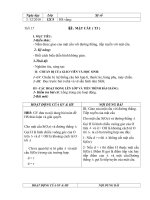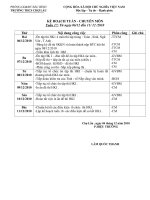May 17 module 12 parasites
Bạn đang xem bản rút gọn của tài liệu. Xem và tải ngay bản đầy đủ của tài liệu tại đây (3.07 MB, 41 trang )
Food-borne Pathogens
Module 12
Eukaryotic Parasites
Eukaryotic parasites
Several different parasites can cause infestations and associated disease in humans
and animals via a food route (or faecal/oral route). Most are acquired due to contamination of crops and by consuming improperly cooked meat of animals infected
with parasites and sometimes due to lack of hygiene by food handlers
The main sources of contamination by parasites include:
1. Use of manure as fertiliser for crops. Manure may contain eggs/cysts of the parasites
2. Livestock infected by parasites are left to graze near crops. They may shed
eggs/cysts of parasites onto ground and potentially contaminate crops
3. Wild animals/birds may spread parasite eggs/cysts onto crops
4. Irrigation water is contaminated by manure or sewage
5. Aerosols from spraying contaminated water or slurries
The main sources of contamination by parasites include:
6. Poor hygiene practices by food handlers
7. Washing food products that are consumed raw with contaminated water
8. Using contaminated water to make ice and frozen/chilled foods
9. Using contaminated water for making food that receives only minimal processing
Entamoeba
Cryptosporidium
tapeworms
Trichinella spiralis
Entamoeba
Toxoplasma gondii
Ascaris
Major foodborne parasites as designated by
the FAO (United Nations)
Parasite
Type
Food type
Taenia spp.
tapeworms
meat
Echinococcus spp.
(E. granulosus, E. multilocularis)
tapeworms
fresh produce
Trichinella spiralis
Nematode (pork
worm)
pork
Opisthorchiidae
flatworms
freshwater fish
Ascaris spp.
Nematode (hook work fresh produce
or round worm)
Cryptosporidium spp.
protozoan
fresh produce, fruit juice, milk
Entamoeba histolytica
protozoan
fresh produce
Toxoplasma gondii
protozoan
meat (except birds), vegetables
Giardia duodenalis
protozoan
fresh produce
Cyclospora cayetanensis
protozoan
fresh produce
Naegleria fowleri
Protozoan
Various (very rare)
Foodborne tapeworms (cestodes)
Taenia
Head (scolex) of Taenia
Rostellum
(showing hooks)
Causes taeniasis
Parasitic infection acquired by consuming eggs
or proglottid (egg packet) of the tapeworm
Three major species
- Taenia saginata – beef tapeworm
- Taenia solium – pork tapeworm
- Taenia asiatica
4 suckers
Parasitism in humans mainly occurs in areas where
beef and/or pork are eaten raw or very lightly cooked
Mostly Latin America, Eastern Europe, Russia, subSaharan Africa, some parts of Asia.
Infestation causes digestive problems: abdominal pain, loss of appetite, weight loss,
upset stomach, shed parts of tapeworm, eggs and proglottids in faeces
Cysticercosis
Taenia solium can cause a more serious illness called cysticercosis
This disease is acquired by eating food contaminated by Taenia solium eggs that come
from a person (usually a food handler) who has Taenia solium infestation
Cannot get this form of parasitism directly from meat (pork)
Infestation spreads to the skin, brain, eyes and muscles
where the tapeworm forms cysts, which become calcified
(cysticerci)
- Leads to swelling, atrophy, fibrosis of muscles
- Eye damage with possible vision loss
- Nodules in the skin that can be painful to touch
- Brain damage leading to seizures, frequent headaches
About 1200 people die each year (worldwide)
Treatment
- anti-helminthic drugs, other drugs to treat symptoms, surgery to remove cysts (e.g. eyes)
Taenia solium lifecycle
The acquisition of the tapeworm is enhanced due to consumption of human faecal
contaminated crops and consumption of meat from infested undercooked pork
Echinococcus spp.
Tapeworm (cestode) genus
that causes a hyatid disease
called echinococcosis
Echinococcosis comes in two forms:
Cystic echinococcosis – obtained from ingesting eggs of Echinococcus granulosus,
associated mainly with canines (the definitive host), livestock (intermediate hosts)
The tapeworm forms slowly cysts in the liver, lungs and other organs such as the bone,
heart, brain, eyes. Rupture of cysts may cause death of the host due to anaphylactic shock.
Alveolar echinococcosis - obtained from ingesting eggs of Echinococcus multilocularis,
associated mainly with canine species (the definitive host), rodents (intermediate hosts)
The tapeworm causes the development of tumour-like formations in various organs
including liver, lungs, and brain. Lack of treatment always results in death.
Treatment: requires chemotherapy and surgical removal of cysts
Echinococcus granulosus life cycle and parasitism
Trichinosis (Trichinella
spiralis)
Contracted from eating raw or undercooked meat of animals infected with the encysted
larvae of the nematode Trichinella spiralis usually from wild and domesticated pigs.
Carnivorous animals (bears, big cats etc.) can also have Trichinella infestations.
- Larval cysts excyst when they pass through the stomach.
- Worms then grow in the intestine causing abdominal pain, diarrhea after 1-2 days
- Worms can move into the muscles, eyes and other organs of the host, curl up and form
new cysts. These cysts calcify. This takes 2-8 weeks. Results in severe muscle pain, weakness,
fatigue, swelling of limbs and face. Drugs are used to eliminate intestinal infestation.
T. spiralis cysts in muscle
Trichinosis causes edema (swelling, due to fluid build up)
near eyes
Trichinella spiralis infection process
Trichinosis can also be caused by some other Trichinella species
Trichinosis
Risk factors and prevention
- Since transmission is largely from undercooked pork meat prevalence of trichinosis is
similar to that of Taenia solium (mainly Latin America, some parts of Asia, Eastern Europe etc.)
- The simplest prevention is by cooking all meat to at least 70-75°C, which
instantly kills the larvae.
- Hygienic raising of pigs and hygienic meat processing also reduce the number of cysts
and the overall risk of infection
Treatment
Trichinosis is best treated with anti-helminthic drugs and drugs to suppress the symptoms
(steroids to reduce muscle pain, swelling). May need to be long term.
Re-emergence
Trichinosis is more common in recent decades, especially China (20000 cases per year with
200 deaths) possibly due to changes in food habits and changes in food availability.
Ascariasis
eggs
Ascariasis is a parasitic infection caused by members of genus Ascaris – the hookworms,
a type of nematode (phylum Nematoda). The most likely culprit species is Ascaris lumbricoides which
Is quite large (up to 35 cm long!)
Ascariasis is the most common form of parasitism in developing nations with 0.8-1.2
billion people infected at any one time.
Most people get infected due to poor public hygiene (faecal oral route). In terms
of foodborne infections ascariasis is due to consumption of contaminated fruits and
vegetables (see slides 2, 3 and 15 for more explanation)
Most people with ascariasis show few symptoms as the host can adjust to the parasitism.
However in some people the parasite load is so high it causes blockage of the intestinal canal, which can
stunt the growth of children. The parasites also can induce constant coughing due to irritation caused
by parasite movement in the body.
Treatment is via antinematodal drugs especially albendazole and mebendazole
Prevention logically involves improvements in public hygiene, sewage treatment and avoidance
of human/animal manure as fertilisers
Life cycle of Ascaris
and human infestation
(info from the CDC)
Opisthorchiasis
Opisthorchiasis is a parasitic disease caused by flatworms (trematodes) of the genus Opisthorchis
The disease is associated with consumption of raw freshwater fish
Prevalence is extremely high in regions of Asia including Laos and Thailand (with up to 70% of people
infected in some specific areas)
In 80% of people infected the disease is largely asymptomatic. A heavily infected person will develop
diarrhea, abdominal pain, lose appetite (anorexia), and be fatigued.
The person may also have swollen legs (edema), develop infections of the gall bladder
(which can be life threatening), damage to the liver and bile duct (indicated by jaundice and enlargement
of the liver and loss of gall bladder function).
Eventually the person my develop bile duct cancer (cholangiocarcinoma) which is a very serious cancer
that rapidly metastasises leading to death in a few months.
Only effective treatment to date is the antitrematodal drug praziquantel
Patients with opistorchiasis do not show good immune response to the parasites so vaccines probably
will be ineffective. Prevention relies on changing eating practices – cooking or preserving fish so that the
parasites are killed.
Opisthorchis
viverrini
Protozoan parasites that can be foodborne and cause illness in humans
Protozoan
Taxonomic
group (phylum)
Food
Infective life
stage
Cryptosporidium spp.
Apicomplexa
fresh produce, fruit juice, oocyst
milk
Cyclospora cayetanensis
Apicomplexa
fresh produce
oocyst
Toxoplasma gondii
Apicomplexa
meat (non-avian)
cyst
Entamoeba histolytica
Amoebozoa
fresh produce
cysts or
trophozoites
Naegleria fowleri
Percolozoa
Various (warm water)
cysts or
trophozoites
Giardia duodenalis
Micromonada
fresh produce
cysts
Several protozoa can be parasites of humans causing disease. Most are obligate parasites.
These protozoa can be acquired through consumption of minimally heat processed
foods or foods contaminated using water containing the protozoan
Some cause mild infections (gastroenteritis) to extremely serious brain disease
that are almost always fatal
Cryptosporidiosis
Cryptosporidiosis (or simply “crypto”)
is a disease in humans caused by
protozoan parasites of the genus
Cryptosporidium (typically species
C. parvum and C. hominis)
Oocysts of C. hominis
The parasite can be consumed by the host and cause infections due to formation of tough
resting stages called oocysts that protect it from environmental stress.
Cryptosporidiosis is common throughout the world and is usually associated with exposure
to contaminated water (faecal oral route) due to improper treatment of sewage. Thus food
Prepared under unhygienic conditions can be exposed to oocyst contamination.
See Module 2 for incidence rates of cryptosporidiosis in the US. It occurs world-wide.
The illness tends to impact immunocompromised people more with symptoms appearing in
2 to 8 days. Main symptoms are severe watery diarrhea, abdominal pain/cramps, nausea,
vomiting, fever. Lasts 1-2 weeks. Some people can suffer illness for 30 days.
Healthier people recover quicker
Cryptosporidiosis
People with poor immune systems (e.g. due to HIV infection )n can develop chronic very serious illness
since the parasite cannot be cleared by the immune system. This results in eventual death of the patient.
Life cycle and transmission
In the hosts exposure of the oocysts to stomach acid causes excystation and the larval cells (sporozoites)
then infect gut cells in order to continue their maturation as trophozoites. Initially trophozoites asexually
divide (merogony) then they undergo sexual differentiation into gametes that are either male or female.
The gametes fertilise each other and then form new oocysts.
The oocysts formed survive in the environment when shed in faeces. Oocysts which remain continue
the cycles of infection and maturation in the host.
Treatment
Drugs and processes are used to minimise the effect of symptoms (e.g. dehydration
from the diarrhea). Direct drug treatment does not seem to work very well since the oocyts can survive.
Prevention
Improved public hygiene, good quality water supplies (chlorination), wash vegetables/fruits with clean
water are the best cure to the crypto problem.
Cryptosporidium have genomes of about 9 megabases and code 3800-5600 proteins (depending on species)
They are very streamlined for life as a dedicated parasite.
Cyclospora cayetanensis
Emerging problem associated with fresh produce contamination
Forms tough oocysts that can survive in the environment and transfer to human
host in contaminated water or food contaminated with oocysts.
Illness is very similar to cryptosporidiosis with the same severe form in
immunocompromised patient
Treatment and prevention similar to Cryptosporidium
Genpme is around 44 megabases coding about 6500 proteins (larger size suggests it
has undergone polyploidy)
Oocyst of Cyclospora cayetanensis
showing size and shape. The stain is
an acid-fast stain and can be used to
detect oocysts in samples
Transmission of Cyclospora
cayetanensis to humans Contaminated food/water that
has oocysts of the parasite present
(similar to Cryptosporidium)
Toxoplasmosis
This is an illness caused by the apicomplexan
protozoan pathogen Toxoplasma gondii
T. gondii is a parasite of most mammalian species
including humans and is found worldwide.
Life cycle of T. gondii
Toxoplasma gondii
There are two phases in the T. gondii life cycle “intestinal” and “extraintestinal”
The intestinal phase occurs in wild and domesticated cats only and produces oocysts.
The extraintestinal phase occurs in all animals (including cats) and produces a larval stage
called a "tachyzoite“. Tachyzoites mature to full adults via a "bradyzoite" stage that can
form cysts in the host.
Transmission of the parasite
The disease toxoplasmosis can be transmitted to humans by ingestion of oocysts (via cat
faeces contamination) or ingestion of bradyzoites (in undercooked meat from an
animal that is already parasitized by T. gondii).
Toxoplasma gondii life cycle and transmission to humans via cysts
Extraintestinal
phase
Intestinal
phase
Toxoplasmosis illness and symptoms
In most humans infected with Toxoplasma gondii, the disease is asymptomatic.
In some people (mainly those who have weak immunity) toxoplasmosis can cause
serious problems - hepatitis (jaundice etc.), pneumonia, blindness, and severe
neurological disorders (depression, schizophrenia-like illness)
Toxoplasmosis can also be transmitted transplacentally resulting in a spontaneous
abortion, a still born, or a child that is severely handicapped mentally and/or
physically.
Toxoplasmosis is thought by some to modify
human behaviour giving rise to “crazy cat
lady syndrome” urban legend
A cat lady is a cultural stereotype of a woman
who compulsively hoards cats and dotes
upon them, often a spinster who is eccentric
The greatest risk is however not properly
preparing food hygienically. Having a large
number of cats as pets is obviously a risk though
Since cats are T. gondii preferred host.









